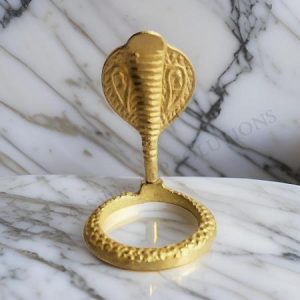The Kritimukha, often called the “face of the demon” or “the face of the deity,” is a distinctive and deeply symbolic motif in Indian art and culture. With its roots embedded in Hindu, Buddhist, and Jain traditions, the Kritimukha is a powerful image that conveys protection, transformation, and the eternal struggle between good and evil. Its appearance in various forms of architecture, sculpture, and sacred art reflects its enduring importance and multifaceted meaning.
Origin and Meaning:
The term “Kritimukha” can be broken down into two Sanskrit words: “Kriti,” meaning “creation,” and “Mukha,” meaning “face.” Thus, the Kritimukha translates to “face of creation.” According to mythological texts, the Kritimukha is said to represent a creature with an open mouth and fierce expression, often depicted as a grotesque or fearsome face. The most common interpretation is that it is a protective symbol, particularly in religious settings.

In Hindu mythology, the Kritimukha is linked to various stories, one of the most famous being its connection to Lord Vishnu. The face is often depicted as having large, wide eyes, a gaping mouth, and sharp teeth, conveying a sense of alertness and readiness to ward off evil. In some accounts, the Kritimukha is seen as a gatekeeper of divine realms, often guarding temples and sacred spaces.

Symbolism of the Kritimukha:
- Protection: The Kritimukha is often placed at the entrances of temples, palaces, and other sacred sites. Its fierce expression is believed to scare away evil spirits and malevolent forces, ensuring the safety of those inside. This protective role is integral to its function in art and architecture.
- Transformation: The Kritimukha’s grotesque appearance is also symbolic of the process of transformation. It represents the cyclical nature of life, death, and rebirth in many traditions. The face is a reminder that all beings must go through periods of destruction and renewal to achieve spiritual growth.
- Balance of Good and Evil: Kritimukha’s fierce face is balanced by the wisdom of the divine, suggesting the idea that even the most fearsome creatures or forces in the world can be understood and integrated into the larger cosmic order. It serves as a reminder of the balance between light and darkness, creation and destruction.
The Kritimukha in Art and Architecture:
The Kritimukha is a prominent feature in Indian temples, particularly in sculptures and carvings. It is often found above doorways, windows, or pillars, where its presence is meant to offer divine protection. Its image is also commonly seen in decorative elements, such as chandeliers, ceiling designs, and paintings, where it continues to symbolize protection and divine blessing.
In addition to temples, the Kritimukha is often seen in ritualistic objects such as altars, incense holders, and lamps. Its design, though fearsome, is meant to evoke awe and respect for the divine and to remind devotees of the importance of guarding one’s spiritual path against negative influences.

Conclusion:
The Kritimukha face, with its multifaceted symbolism and historical significance, continues to be a vital element in Indian art, culture, and spirituality. Whether as a guardian figure in temple architecture or as a symbolic representation of the forces of creation and destruction, the Kritimukha embodies the dynamic balance of life’s many complexities. It serves as a powerful reminder that while the world may be full of challenges, protection and transformation are always within reach for those who seek the divine.
Address: 34/35 Mathura Vihar,
Vijay Nagar, Jabalpur (M.P.)
Pin: 482002
Phone: +919713099668
Email: salvusestore@gmail.com







